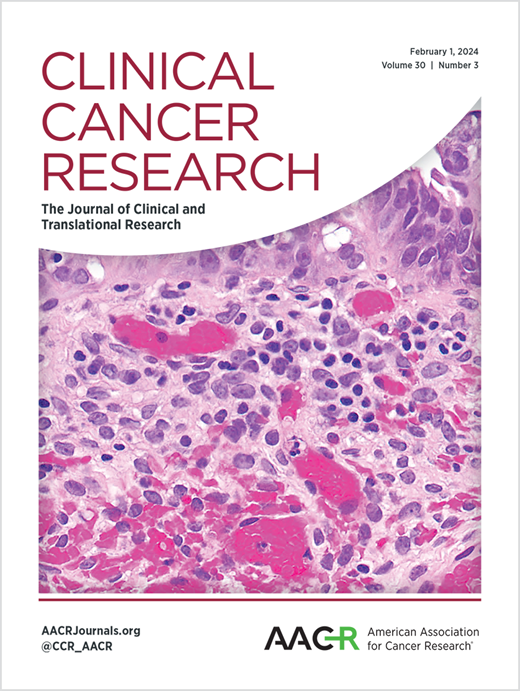循环肿瘤DNA作为分子生物标志物在伊马替尼加比尼替尼治疗晚期胃肠道间质瘤患者的II期临床试验
IF 10.2
1区 医学
Q1 ONCOLOGY
引用次数: 0
摘要
目的:本研究在伊马替尼和比尼替尼治疗新诊断的晚期GIST的II期试验中,研究影响ctDNA检测和ctDNA作为分子生物标志物的因素,包括在试验入组后4周内暴露于伊马替尼的患者。实验设计血浆和肿瘤组织样本在基线、治疗中和进展时收集。从血浆和肿瘤组织中提取的dna分别使用基因组测定试剂盒MSK-ACCESS和MSK-IMPACT进行分析。确定了主要致癌驱动因素的测序ctDNA检测并与临床特征相关。结果纳入的患者(n=31)有KIT突变(n=29, 94%)、转移性疾病(n=24, 77%),在部分缓解(n=22, 71%)、稳定(n=8, 26%)和进展性疾病(n=1, 3%)中获得最佳疗效。16名患者(52%)在基线时暴露于伊马替尼。基线时主要致癌驱动因素的ctDNA检出率为39% (n=12/31),在treatment-naïve (n=15)或治疗≤4.2周(n=8)的患者中,ctDNA检出率明显高于其他患者(48%对13%,p值= 0.004)。基线ctDNA检测与肿瘤负荷或分期无关。主要致癌驱动因素的ctDNA序列分析与放射学反应平行,有时先于放射学反应。CtDNA检测到KIT耐药突变(n=4)。积极治疗影响了1例患者继发性KIT改变的检测。结论:在收集ctDNA时进行积极治疗会对晚期GIST患者检测已测序ctDNA中原发性和继发性KIT改变的能力产生负面影响。CtDNA反应可能先于放射学反应,值得进一步研究。本文章由计算机程序翻译,如有差异,请以英文原文为准。
Circulating tumor DNA as a molecular biomarker in the phase II trial of imatinib plus binimetinib in patients with advanced gastrointestinal stromal tumors.
PURPOSE
This study investigated factors that affected ctDNA detection and ctDNA as a molecular biomarker in a phase II trial of imatinib and binimetinib in newly diagnosed advanced GIST, including patients exposed to imatinib within 4 weeks of trial enrollment.
EXPERIMENTAL DESIGN
Plasma and tumor tissue samples were collected at baseline, on-treatment, and upon progression. DNAs extracted from plasma and tumor tissue were analyzed using genomic assays, MSK-ACCESS and MSK-IMPACT, respectively. Sequenced ctDNA detection of the primary oncogenic driver was determined and correlated with clinical characteristics.
RESULTS
Patients (n=31) included in this analysis had KIT mutant (n=29, 94%), metastatic disease (n=24, 77%), and achieved the best response of partial response (n=22, 71%), stable (n=8, 26%) or progressive disease (n=1, 3%). Sixteen patients (52%) were exposed to imatinib at baseline. The ctDNA detection rate of the primary oncogenic driver at baseline was 39% (n=12/31), and significantly more likely in patients that were treatment-naïve (n=15) or had ≤4.2 weeks of treatment (n=8) than otherwise (48% versus 13%, p-value = 0.004). Baseline ctDNA detection did not correlate with tumor burden or stage. The ctDNA serial analysis of the primary oncogenic driver paralleled and sometimes preceded radiographic response. CtDNA detected resistance mutations in KIT (n=4). Active treatment influenced detection of secondary KIT alterations in one patient.
CONCLUSIONS
Active therapy at the time of ctDNA collection negatively affected the ability to detect primary and secondary KIT alterations in sequenced ctDNA from patients with advanced GIST. CtDNA responses may precede radiographic responses, and merits further investigation.
求助全文
通过发布文献求助,成功后即可免费获取论文全文。
去求助
来源期刊

Clinical Cancer Research
医学-肿瘤学
CiteScore
20.10
自引率
1.70%
发文量
1207
审稿时长
2.1 months
期刊介绍:
Clinical Cancer Research is a journal focusing on groundbreaking research in cancer, specifically in the areas where the laboratory and the clinic intersect. Our primary interest lies in clinical trials that investigate novel treatments, accompanied by research on pharmacology, molecular alterations, and biomarkers that can predict response or resistance to these treatments. Furthermore, we prioritize laboratory and animal studies that explore new drugs and targeted agents with the potential to advance to clinical trials. We also encourage research on targetable mechanisms of cancer development, progression, and metastasis.
 求助内容:
求助内容: 应助结果提醒方式:
应助结果提醒方式:


